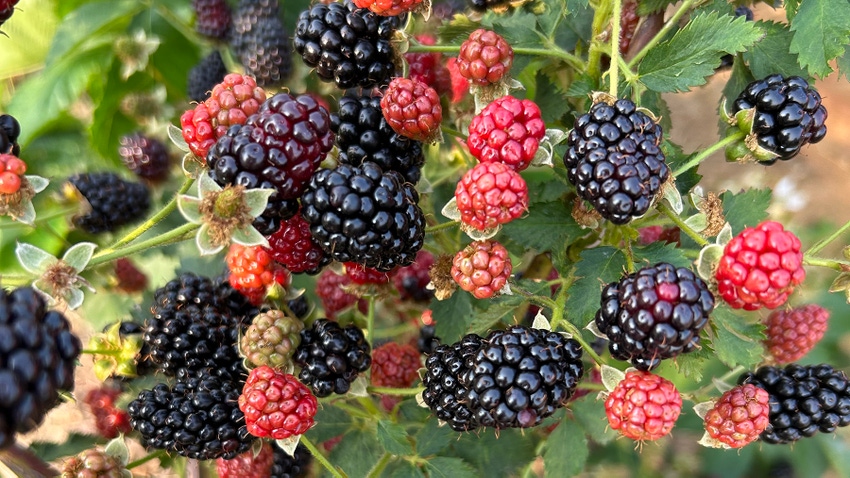
Despite leaps in Arkansas blackberry breeding over the past few decades, there is still room for advancement with the help of genome-wide association mapping, consumer panels and a machine with a mouthful of a name — a gas chromatography-olfactometry-mass spectrometer.
Margaret Worthington, associate professor of fruit breeding and genetics for the Arkansas Agricultural Experiment Station, has tasted a lot of blackberries and knows what a good berry tastes like. But consumer sensory panels are more accurate and objective than a fruit breeder’s ratings, Worthington said.
As the principal investigator for a new U.S. Department of Agriculture grant, she will use new genomic tools and novel approaches for improving flavor to support her efforts in propelling the largest public-sector breeding program for fresh-market blackberries in the United States.
The University of Arkansas System Division of Agriculture’s blackberry breeding program has developed and patented 43 fresh-market blackberry cultivars, including many combining erect growth habit, thornlessness, and improved shipping ability. The first primocane-fruiting blackberry cultivars, which produce fruit on first-year canes, were also developed in the breeding program. The experiment station is the research arm of the Division of Agriculture.
Grant source
The USDA's National Institute of Food and Agriculture will administer the $650,000 Agriculture and Food Research Initiative grant over the next four years. In addition to more data from consumer panels, the grant also provides funding to conduct studies that identify genomic variants statistically associated with a particular trait, known as genomewide association mapping.
Consumer sensory panels are considered the “gold standard for evaluating flavor in fruit crops,” Worthington said, but they cost money and time.
“This is all about discovering what drives consumer preference,” Worthington said. “Comparing the chemistry data on blackberries with consumer panel data, we’ll have much more power to make inferences about what consumers want and how to breed blackberries.”
She said that even with the rise in blackberry consumption and sales, inconsistent flavor is considered a barrier to industry growth. She added that a common complaint about blackberries from consumers and grocers is that they are too tart or not sweet enough, either from being picked too early or simply having an “off” taste.
Sensory panel data
The USDA-NIFA grant will support investigations that tie in the consumer sensory panel data with the different flavor volatiles found in the blackberry genotypes most favored by consumers, which is where the gas chromatography-olfactometry-mass spectrometer plays a role. This instrument can be used to analyze the chemical components of blackberry flavors, including specific flavor and aroma compounds called “volatiles.”
Although the basic tastes of blackberries — sweetness, sourness, and bitterness — impact their flavor, volatile aroma compounds are also responsible for typical aromas and aromatic flavors of blackberries, Worthington noted. Volatiles are substances in fruit that vaporize easily at ambient temperature. In blackberries, those volatiles include acids, esters and alcohols, but vary by variety, ripeness, harvest time and storage conditions.
Worthington will take all the information collected to help guide selections for advancing blackberry plants in breeding trials.
The grant also provides funding for a Ph.D. student, Katelyn Lust-Moore.
“We want to look for correlations between certain volatiles and consumer preferences to determine what exactly makes the flavor of a blackberry desirable or off-putting,” Lust-Moore, said. “Then, we can use this information to create tools for breeders so they can more efficiently select plants that produce better-tasting fruit.”
Research team
Worthington, who is part of the horticulture department, is teaming up with food science researchers Renee Threlfall, research scientist of horticultural postharvest/quality, and Scott Lafontaine, assistant professor of flavor chemistry; Samuel B. Fernandes, assistant professor of agricultural statistics and quantitative genetics with the experiment station’s Center for Agricultural Data Analytics; and Lust-Moore.
Worthington noted the collaboration includes complimentary fields and tools. Lafontaine, for example, operates the Shimadzu gas chromatography-olfactometry-mass spectrometer that evaluates samples for chemical analysis. And Fernandes combines computer science advances with elements of agriculture to help plant breeders, growers and consumers.
Two prerequisites
Worthington said this scale of a project would not have been feasible even a few years ago.
One factor that makes the project possible is her work with a team of international scientists who assembled the first complete sequence of the blackberry genome. Another factor, oddly enough, was the COVID-19 pandemic.
During the pandemic, when restrictions prevented researchers from conducting sensory panels, Threlfall and her team devised a protocol that allowed them to preserve blackberries until restrictions were lifted. They froze the blackberries after harvest, thawed them, and made a puree for tasting right before the sensory panels took place.
Operating consumer sensory panels during the blackberry harvest season is difficult to manage in tandem with regular blackberry breeding duties, Worthington said. Threlfall’s pandemic-era protocol will allow Worthington’s team to conduct the sensory panels in the winter and spring when they are less busy with blackberry breeding duties.
The blackberry research is supported by USDA grant number 2023-6703-39448.
Source: University of Arkansas System Division of Agriculture
Read more about:
BlackberriesAbout the Author(s)
You May Also Like




